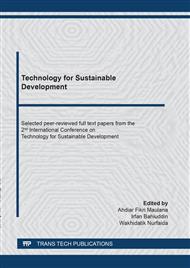[1]
Goldzweig, C., Towfigh, A., Maglione, M., & Shekelle, P. (2009). Costs and Benefits of Health Information Technology: New Trends from the Literature. Health Affairs, 28(2).
DOI: 10.1377/hlthaff.28.2.w282
Google Scholar
[2]
Khodambashi, S. (2013). Business Process Re-Engineering Application in Healthcare in a Relation to Health Information Systems. Procedia Technology, 9.
DOI: 10.1016/j.protcy.2013.12.106
Google Scholar
[3]
Menteri Kesehatan Republik Indonesia. (2008). Peraturan Menteri Kesehatan Republik Indonesia Nomor 269/MENKES/PER/III/2008 tentang Rekam Medis.
DOI: 10.31849/dinamisia.v6i4.10422
Google Scholar
[4]
Presiden Republik Indonesia. (2004). Undang-undang Republik Indonesia Nomor 29 Tentang Praktik Kedokteran.
DOI: 10.31219/osf.io/8e6an
Google Scholar
[5]
Goodman, C. (2005). Savings in Electronic Medical Records System? Do It for The Quality. Health Aff (Millwood), 24(5).
Google Scholar
[6]
Schenarts, P. J., & Schenarts, K. D. (2012). Educational Impact of The Electronic Medical Record. Journal of Surgical Education, 105-112.
DOI: 10.1016/j.jsurg.2011.10.008
Google Scholar
[7]
Perera, G., Holbrook, A., Thabane, L., Foster, G., & Willison, D. J. (2011). Views on Health Information Sharing and Privacy from Primary Care Practices Using Electronic Medical Records. International Journal of Medical Informatics, 80.
DOI: 10.1016/j.ijmedinf.2010.11.005
Google Scholar
[8]
Lamberts H, Wood M. (2002).The Birth of the International Classification of Primary Care (ICPC). Serendipity at the border of Lac Léman. Fam Pract.
DOI: 10.1093/fampra/19.5.433
Google Scholar
[9]
WONCA International Classification Committee, W.O. of F.D., (2005) International Classification of Primary Care ICPC-2R Revised Second Edition, New York: Oxford University Press Inc.
Google Scholar
[10]
Verbeke, M., Schrans, D., Deroose, S., & De Maeseneer, J. (2006). The International Classification of Primary Care (ICPC-2): an essential tool in the EPR of the GP. Studies in Health Technology and Informatics.
Google Scholar
[11]
Idaiani, S. (2016). Penyakit-Penyakit Di Bidang Psikiatri Yang Harus Dituntaskan di Puskesmas. Jurnal Kebijakan Kesehatan Indonesia, 5 (4).
Google Scholar
[12]
Rahman, S. M., Angeline, R. P., Cynthia, S., David, K., Christopher, P., Sankarapandian, V., & Kumar, Y. (2014). International classification of primary care: An Indian experience. Journal of Family Medicine and Primary Care.
DOI: 10.4103/2249-4863.148111
Google Scholar
[13]
Soler JK, Okkes I. (2012) Reasons for encounter and symptom diagnoses: A superior description of patients' problems in contrast to medically unexplained symptoms (MUS). Fam Pract.
DOI: 10.1093/fampra/cmr101
Google Scholar
[14]
Bernstein RM, Hollingworth GR, Viner GS, Goyal S. Vancouver, B.C. (2000). Scientific Program Proceedings: A Proposed Data Model For Primary Care Electronic Medical Records. COACH (Canadian Organization for Advancement of Computers in Health Care), InFocus.
Google Scholar
[15]
Santoso, D. B., Nuryati, N., & Pramono, A. E. (2020). Pengembangan Rekam Medis Elektronik Berbasis Software as a Service (SaaS) bagi Dokter Praktik Mandiri. Jurnal Kesehatan Vokasional, 5(3).
DOI: 10.22146/jkesvo.55586
Google Scholar
[16]
Benlian, A., Hess, T. (2011). Opportunities and risks of software-as-a-service: Findings from a survey of IT executives. Decision Support Systems, 52.
DOI: 10.1016/j.dss.2011.07.007
Google Scholar
[17]
Okkes, I.M. et al., (2000) ICPC-2-E: The Electronic Version of ICPC-2. Differences from The Printed Version And The Consequences. Family Practice, 17(2).
DOI: 10.1093/fampra/17.2.101
Google Scholar
[18]
Wang, S. J., Middleton, B., Prosser, L. A., Bardon, C. G., Spurr, C. D., Carchidi, P. J., et al. (2003). A Cost-Benefit Analysis of Electronic Medical Records in Primary Care. American Journal of Medicine, 114.
DOI: 10.1016/s0002-9343(03)00057-3
Google Scholar
[19]
Hatta, G., (2012) Pelatihan Elektronis on-line ICD10 (2010) dan ICPC-2R (2005), Jakarta.
Google Scholar
[20]
Hsiao, C.-J., Hing, E., Socey, T., & Cai, B. (2011). Electronic Health Record System and Intend to Apply for Meaningful Use Incentives Among Office-based Physician Practices: United States 2001-2011. Hyattsville: National Center for Health Statistics.
Google Scholar
[21]
Putri, F. E. (2010). Perancangan Aplikasi Pelaporan pada Sistem Informasi Dokter Keluarga Berbasis Web di Wilayah Kota Yogyakarta. Surakarta: Universitas Muhammadiyah Surakarta.
Google Scholar
[22]
Wockenfuss, R. et al., (2009) Three-and four-digit ICD-10 is not a reliable classification system in primary care, Scandinavian Journal of Primary Care, Informa Healthcare, 27.
DOI: 10.1080/02813430903072215
Google Scholar
[23]
Suryani, D. L. & Lazuardi, L (2017). Evaluasi konversi ICPC-2r dari ICD Sebagai Upaya Peningkatan Kualitas Pelayanan Puskesmas. Journal of Information Systems for Public Health, 2(1).
DOI: 10.22146/jisph.8688
Google Scholar
[24]
Samra, J. (2015). Comparing Performance of Plain PHP and Four of Its Popular Framework. Kalmar: Linnaeus University.
Google Scholar
[25]
Budde, R., Kautz, K., Kuhlenkamp, K., & Zullighoven, H. (2011). Prototyping - an Approach to Evolutionary Development. Berlin: Springer-Verlag.
Google Scholar
[26]
Kushniruk, A., & Patel, V. (2004). Cognitive and usability engineering methods for the evaluation of clinical information systems. Journal of Biomedical Informatics.
Google Scholar
[27]
Kreger, H. (2003). Fulfilling The Web Services Promise. Communication of the ACM, 46(6).
Google Scholar
[28]
Gimbel, S. et al., (2011) An Assessment of RoutinePprimary Care Health Information System Data Quality in Sofala Province, Mozambique. Population Health Metrics, 9(1).
DOI: 10.1186/1478-7954-9-12
Google Scholar


